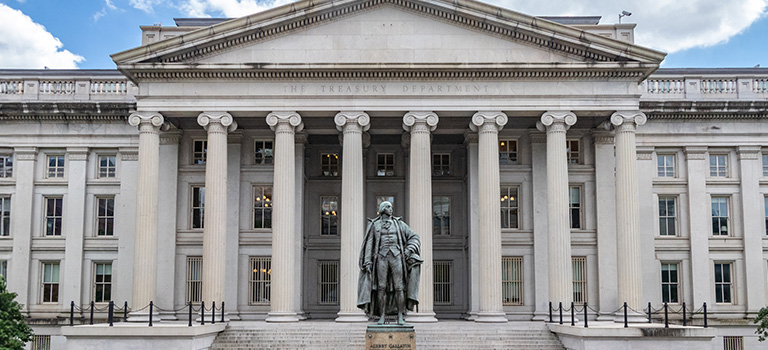The US dollar remains the undisputed heavyweight in the global financial system – central banks hoard it, global trade is priced in it, and financial markets are built around it. However, that dominance, long taken for granted, is being tested. From shifting geopolitical alliances to evolving investment behaviour, the forces nibbling at the dollar’s dominance are multiplying. There is no clear successor so far, but cracks are forming in the foundation.
For decades, the dollar has anchored the global monetary system – not only because of US economic power, but also due to its deep, liquid capital markets and perceived political stability. However, these advantages are no longer absolute. International investors, once content to be heavily exposed to US assets, are starting to hedge their bets more actively. Combine that with rising US debt, policy unpredictability, and a trend toward regional currency use in trade, and the case for a weaker dollar, at least in the near term, starts to build.
Dollar’s gradual diminishing role
Let’s be clear: there’s still no real alternative to the dollar. The euro lacks a true fiscal union and deep bond markets. The yuan remains constrained by capital controls. Even with all the talks about multipolar currencies, the dollar remains deeply embedded in how the world trades, borrows, and invests.
The dollar currently makes up 58% of global foreign exchange reserves, more than 80% of global FX turnover, and one-third of global debt is issued in dollars. These are not numbers that shift quickly. Two decades ago, the dollar’s reserve share was closer to 70%. Central banks have steadily diversified – into the euro, yen, sterling, and the “others” category that includes the Australian dollar, Canadian dollar, and Swiss franc. And growing geopolitical tensions and trade fragmentation are only accelerating that shift.
Trade fragmentation is chipping away at dollar dominance
The dollar still dominates trade between advanced economies and emerging economies (EM). But trade between EMs is increasingly bypassing the dollar, with more transactions being settled in local currencies or alternatives.
As of 2022, about 75% of global trade involved advanced economies, and only 25% was EM-to-EM or EM-to-China trade. That smaller slice in trade among EMs is where de-dollarisation is gaining ground. It’s not enough to unseat the greenback, but it’s reshaping parts of the global economy.
Structural risks from within
The bigger risks to the dollar may come from within. US federal debt is projected to hit 99% of GDP in 2024 and 118% within a decade, according to the US Congressional Budget Office. This raises concerns about the long-term appeal of US government bonds (Treasuries) as the world’s preferred safe asset.
Foreign ownership of Treasuries is already slipping. For years, overseas investors, especially official institutions such as central banks, held large portions of US debt. However, with slower reserve accumulation and greater diversification, foreign holdings of Treasuries and corporate bonds have fallen to about 30% of outstanding amounts.
There are no signs of a broad sell-off, but the US may have to offer higher yields to keep attracting global capital as issuance continues to rise.
Hedging of FX risks increasingly important
Beyond central banks and trade, a quiet shift is happening among institutional investors. Foreign investors have accumulated USD 56.6 trillion in US financial assets, up from just $2.2 trillion in 1990. That includes $16.5 trillion in equities and another $14.5 trillion in debt securities, with foreign direct investment accounting for a further $16.5 trillion.
For many years, many investors – pension funds, insurance companies, sovereign wealth funds – didn’t hedge their dollar exposure aggressively. The dollar’s historical tendency to rise in times of stress made it a natural portfolio hedge. This so-called “USD smile” worked well for years but it is fading.
Treasuries and the dollar have become less reliable during market stress. That’s made the cost of being unhedged far more painful. As a result, we’re seeing early signs of increased FX hedging activity. If this continues, it could create sustained downward pressure on the dollar through active USD selling.
Gold: diversification in uncertain times
If there’s a winner from the de-dollarisation push, it’s gold. Central banks, especially in EMs, have ramped up gold purchases. The People’s Bank of China, for instance, resumed gold buying in 2022 after a three-year pause.
According to the World Gold Council, net central bank gold purchases reached 1,045 metric tonnes in 2024. Gold now accounts for an estimated 14% of global reserves, up from 8.3% in 2018. Part hedge, part symbol, gold’s appeal is clear in a world of rising inflation, geopolitical friction, and currency uncertainty.
What this means for investment portfolios?
In the near term, these forces point to a softer dollar, especially if FX hedging continues to increase. Over time, the dollar is unlikely to lose its primacy, but its share in global reserves, debt markets, and transactions may continue to gradually erode. Investors, policymakers, and institutions would be wise to plan for a world where the dollar’s leadership becomes more contested.
It’s important for global investors to distinguish between cyclical and structural dollar weakness. The former, driven by interest rate differentials, relative US equity market underperformance or mean reversion in terms of valuations, calls for tactical repositioning away from the dollar. But structural weakness, rooted in lasting shifts in global trade, reserve composition, and capital flows, would require rethinking strategic asset allocation.
For now, tactical allocation shifts would involve increasing exposure to non-US equities and local-currency bonds, or adding to gold on dips, not just as a short-term hedge, but as a long-term diversifier. In structural allocations, the dollar remains a foundation currency, but portfolios will likely need to be tweaked in the coming years to reflect the global rebalancing of economic, trade and geopolitical shifts.
This article is for general information only and it does not constitute an offer, recommendation or solicitation of an offer to enter into any transaction or adopt any hedging, trading or investment strategy, in relation to any securities or other financial instruments. This article has not been prepared for any particular person or class of persons and does not constitute and should not be construed as investment advice or an investment recommendation. It has been prepared without regard to the specific investment objectives, financial situation or particular needs of any person or class of persons. You should seek advice from a licensed or an exempt financial adviser on the suitability of a product for you, taking into account these factors before making a commitment to purchase any product or invest in an investment. In the event that you choose not to seek advice from a licensed or an exempt financial adviser, you should carefully consider whether the product or service described herein is suitable for you.
You are fully responsible for your investment decision, including whether the investment is suitable for you. The products/services involved are not principal-protected and you may lose all or part of your original investment amount.
Standard Chartered Bank (Singapore) Limited will not accept any responsibility or liability of any kind, with respect to the accuracy or completeness of information in this article.
Singapore dollar deposits of non-bank depositors are insured by the Singapore Deposit Insurance Corporation, for up to S$100,000 in aggregate per depositor per Scheme member by law. For clarity, these investment products are not deposits and do not qualify as an insured deposit under the Singapore Deposit Insurance and Policy Owners’ Protection Schemes Act 2011. Foreign currency deposits, dual currency investments, structured deposits and other investment products are not insured.
The information stated in this article is accurate as at the date of publication.




